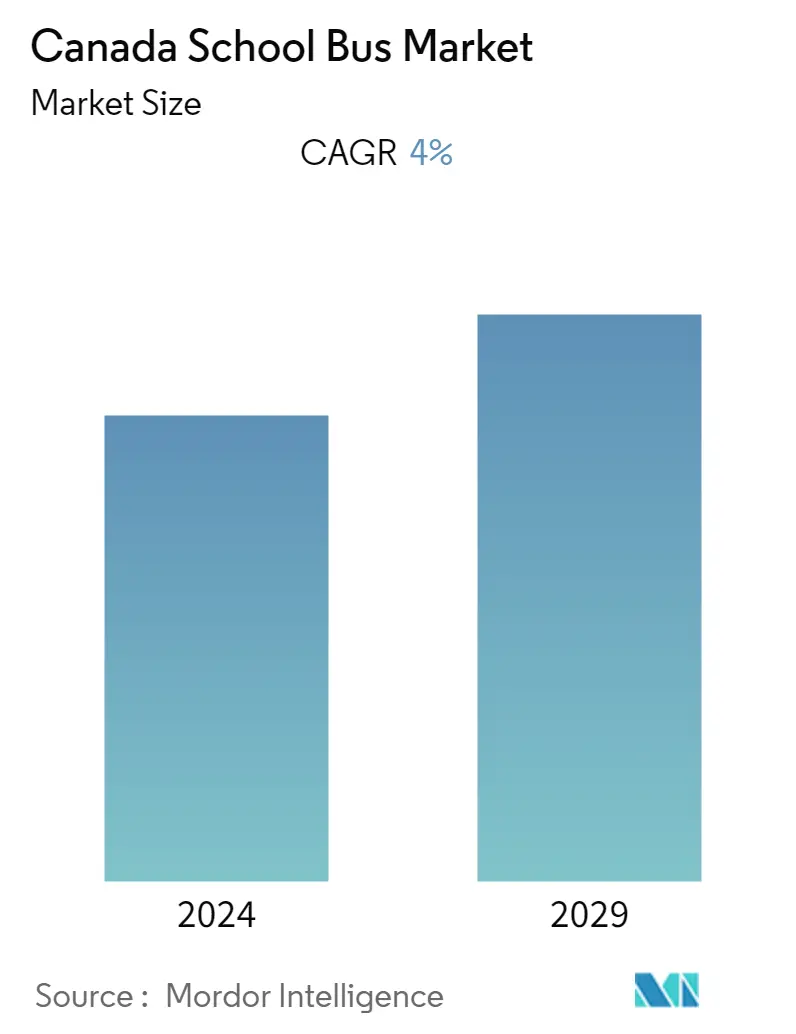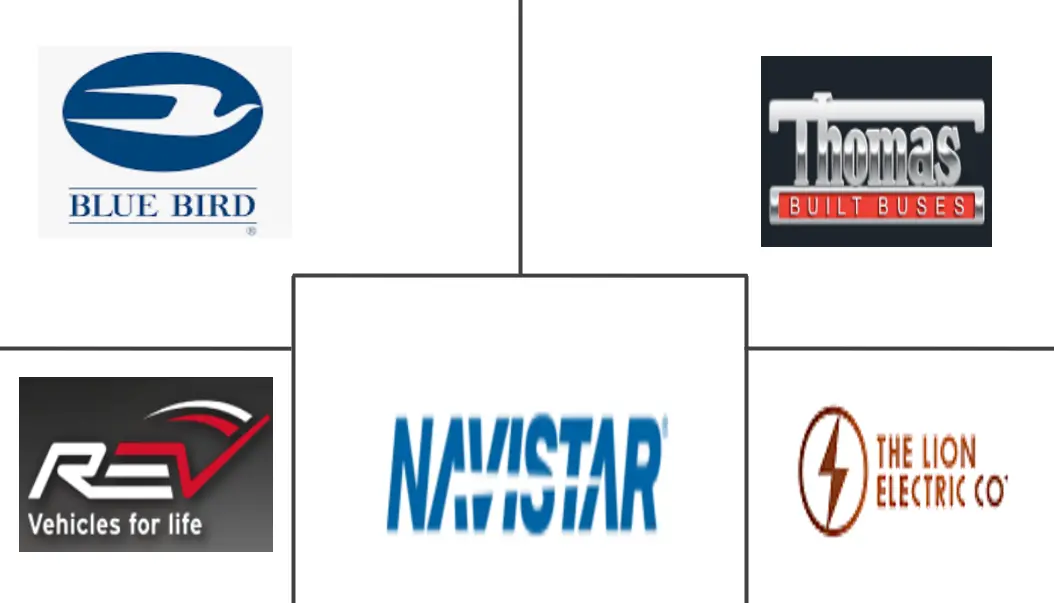Market Size of Canada School Bus Industry

| Study Period | 2019 - 2029 |
| Base Year For Estimation | 2023 |
| Forecast Data Period | 2024 - 2029 |
| Historical Data Period | 2019 - 2022 |
| CAGR | 4.00 % |
| Market Concentration | High |
Major Players
*Disclaimer: Major Players sorted in no particular order |
Canada School Bus Market Analysis
The Canadian school bus market is valued at USD 352.92 Million in 2021 and is projected to grow at a value of USD 446.56 Million at a CAGR of 4.0% during the forecast period 2022-2027.
In the wake of the COVID-19 pandemic, the market is expected to witness nominal growth due to continuous lockdown and travel restrictions across the country. 2020 was the year that saw the downfall of all the major automotive industries, especially the school bus market across Canada, due to the widespread of COVID-19.
The advantage of school buses over the other modes of transport for students is also one reason for augmenting the market's growth during the forecast period. School buses are generally built with high safety standards, protective seating, rollover protection, etc. The rising number of children enrolling in schools across Canada is likely to increase the demand for school buses across the country. This results in the increased demand for a large number of schools and adequate infrastructure for the education industry, which includes transportation and other amenities.
The increasing adoption of electric vehicles in the commercial vehicle segment has influenced the school bus segment across Canada. Electric buses are 2 to 3 times more expensive to manufacture than diesel equivalents, and many of the low-income areas with the most children in need of cleaner commutes are also the ones least able to afford to replace their fleets, which is likely to restrain the market.
Canada School Bus Industry Segmentation
School buses are the safest form of transportation in Canada. Taking a school bus is safer than any other way for students to travel to school, including riding a bicycle, being driven in a passenger vehicle, or walking.
The scope of the report covers the latest trends and technologies followed by COVID-19 impact on the market. The Canada school bus report covers segmentation by propulsion and by bus length. Based on the propulsion, the market is segmented into the internal combustion engine, electric, and hybrid. Based on the Design type, the market is segmented into Type A, Type B, Type C, and Type D.
| Propulsion | |
| Internal Combustion Engine | |
| Hybrid and Electric |
| By Design Type | |
| Type A | |
| Type B | |
| Type C | |
| Type D |
Canada School Bus Market Size Summary
The Canadian school bus market is experiencing a gradual recovery and growth trajectory following the disruptions caused by the COVID-19 pandemic, which had a significant impact on the automotive sector, including school buses. The market is driven by the inherent advantages of school buses, such as high safety standards and protective features, which make them a preferred mode of transport for students. The increasing enrollment of children in schools across Canada is expected to boost the demand for school buses, necessitating the expansion of educational infrastructure, including transportation services. The transition towards electric vehicles is also influencing the market, with initiatives in provinces like Quebec testing and adopting electric buses. However, the higher manufacturing costs of electric buses compared to diesel counterparts pose a challenge, particularly in low-income areas where the need for cleaner commutes is critical.
Government initiatives and investments are playing a crucial role in promoting the adoption of electric school buses in Canada. Programs like Infrastructure Canada's Zero Emission Transit Fund are supporting the transition towards electric mobility, with significant financial backing from the federal government. Despite the slow adoption rate, the presence of electric bus companies and ongoing developments in the sector are expected to drive demand for electric school buses. The operational life of school buses is decreasing due to evolving safety regulations and technological advancements, which is anticipated to increase the demand for new buses. Major players in the market, such as Blue Bird Corporation and The Lion Electric Co., are expanding their offerings and forming strategic partnerships to enhance market growth. These developments, coupled with a focus on safety and sustainability, are expected to create substantial opportunities in the Canadian school bus market over the forecast period.
Canada School Bus Market Size - Table of Contents
-
1. MARKET DYNAMICS
-
1.1 Market Drivers
-
1.2 Market Restraints
-
1.3 Industry Attractiveness - Porter's Five Forces Analysis
-
1.3.1 Threat of New Entrants
-
1.3.2 Bargaining Power of Buyers/Consumers
-
1.3.3 Bargaining Power of Suppliers
-
1.3.4 Threat of Substitute Products
-
1.3.5 Intensity of Competitive Rivalry
-
-
-
2. MARKET SEGMENTATION
-
2.1 Propulsion
-
2.1.1 Internal Combustion Engine
-
2.1.2 Hybrid and Electric
-
-
2.2 By Design Type
-
2.2.1 Type A
-
2.2.2 Type B
-
2.2.3 Type C
-
2.2.4 Type D
-
-
Canada School Bus Market Size FAQs
What is the current Canada School Bus Market size?
The Canada School Bus Market is projected to register a CAGR of 4% during the forecast period (2024-2029)
Who are the key players in Canada School Bus Market?
Blue Bird Corporation, Thomas Built Buses Inc., Navistar International, REV Group and Lion Electric Co are the major companies operating in the Canada School Bus Market.

